
Since my college days, I’ve been experimenting a lot with different materials. To me, each idea normally chooses its own material. In the last 5 years, I’ve been experimenting with paper. For this body of work, paper was the perfect material. I wanted to work with layers. The idea isn’t about the completeness of works but the process. This includes the physical creation process. And the process of these characters was more based on layers.
Thadde Tewa in conversation with David Thuku from Kenya.
Observer III, 2016, Courtesy of One Off Contemporary Art Gallery, Nairobi
David Thuku, Still-in Motion
David Thuku was born in 1985 in Nakuru, Kenya.

Courtesy of Calvin Mwanza/David Thuku
A recipient of the Langalanga Scholarship Fund (a U.K based Charity Organization that supports the education of young, bright and needy Kenyan kids), he is a Diploma graduate from the BuruBuru Institute of Fine Arts in Nairobi.
In 2013, he co-founded Brush-Tu Art Studio, a creative arts collective providing artists with studio space and collaborative exchange. He has exhibited extensively in Nairobi and recently participated in international Art Fairs including 1:54 Contemporary African Art Fair, Young International Art Fair, Drawing Now Paris and Also Known As Africa Art Fair (AKAA).
Thuku works in a variety of media; from conventional oil paint on canvas, to a more recent focus on paper. He cuts and peels paper away to reveal carefully constructed images. These works on paper explore the nature of social structure, identity and urban migration through semi-abstract portraits. They analyze the everyday space we occupy, peeling layers away to uncover hidden dimensions. He uses repeated motifs to indicate a spatial environment and character. Pattern has particular significance in his work. It creates a sense of space, perspective, and comparison and signifies continuity.
Thuku lives and works in Nairobi. (Artist Profile Courtesy of One Off Contemporary Art Gallery, Nairobi)
Thadde Tewa sits down with Nairobi-based Contemporary visual artist, David Thuku to trace his journey in art.
For the two and a half years I’ve known David Thuku, I’ve known him as a very talented artist who is easy to talk to, above all very open-minded and honest about his art practice and the Kenyan art scene in general.
Thuku recently had a solo exhibition titled Still-in Motion, from 30th November 2019 to 12 January 2020 at One Off Contemporary Art Gallery in Gigiri, Nairobi. This is neither my first nor the last meaningful conversation with the brilliant paper art master. Enjoy!
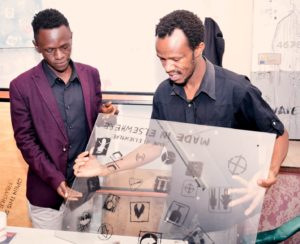
Courtesy of Calvin Mwanza/Kobo Trust Art Studio
TT: Kindly indulge me on your early career beginnings and art education?
DT: Actually everyone around me knew that I was an artist from an early age, except myself ha-ha. I was this bright and playful kid in school who used to draw and create things during my free time but I never saw myself as an artist or imagined I would be an artist; maybe because my idea of an artist was this person with special training or qualifications. Perhaps not having met anyone who was pursuing art professionally partly played into that. The only people I used to see that were close to being artists were sign-writers and screen printers.
I went to a primary school that was partially funded by donors, leading to the construction of more classrooms. As result, some foreign visitors would stop by our school and the administration would organize programs to welcome them. I wasn’t actively involved in the entertainment activities but I was always the one entrusted with creating art gifts since the teachers were aware of my talent. Looking back, I had this friend in the same school that had sketchbooks and other art materials, which honestly, he wasn’t using. So he would force me to fill them up ha-ha. I can actually give him credit for who I am now.
On progressing to high school, there was no doubt I would choose art and design. To enlighten and show us that art is a viable career, our high school teacher would curate workshops and classes and invite artists and art practitioners to train us. On top of that, he told us of art colleges and institutions that we could go to in case we wanted to pursue art afterwards. This was an inspiration to me but still, I wasn’t sure I wanted to be a professional artist. The uncertainty didn’t hinder me from creating art since we had a fully equipped art room with art supplies.
I was fortunate to be part of art projects within the school. I remember our first commission was a big world map that is still in the school. We were not paid a lot but it was a great experience. Actually, we were harassed by the head teacher for asking for more money ha-ha.
In 2006, I received a scholarship to go to an art school through an organization called Langalanga Scholarship Fund, a UK-based charity organization that helps needy and bright kids here in Kenya. I went further and studied fine art, drawing and painting at BIFA from 2007 – 2009. This was a major milestone in my journey towards becoming a professional artist. During this period, I was very active in visiting art spaces like Kuona Trust and ongoing exhibitions at Alliance Française de Nairobi. Every year, we used to be involved in set designing for schools. I used to depend on portrait commissions and once in a while murals. Transitioning from being an art student to a full-time artist was a major challenge and of course, it took some time.
TT: Take me back to the birth of Brush-Tu Art Studio, then your transition to Kuona Artist Collective and later Kobo Trust Artists Space.
DT: I met Maina Boniface in 2010 who was a partner in several art projects I had earlier mentioned. Later on, Michael Musyoka joined the team and I remember most of our clients and art enthusiasts asked where we were based. It was so awkward to say we worked from our homes. These inquiries prompted us to consider getting our own space, a place we could invite our clients and art lovers. After making that decision, we started saving up for the project. Our first space was actually not far from the current Brush-Tu location. It was small but perfect for our budget and the idea we had in mind. Later on, we registered the name Brush-Tu which translates in Kiswahili to “Brush Only” or “Just a Brush” and moved to a new location in August 2016. The first months were challenging especially with the rent and art materials but we relied on murals and other general art commissions. Marketing and pulling art lovers to the studio was a bit of a challenge but things changed gradually. Later on, other members like Elias Mung’ora and Waweru Gichuhi joined us which made things more easier in terms of rent and overheads. We moved a bit and expanded the space and welcomed more members like B.N Kimani, Peteros Ndunde, Lincoln Mwangi, Emmaus Kimani and Abdul Kipruto, who were our friends. And now we have female artists too; Moira BushKimani and Sebawali Sio as the official members. We have been running a couple of residencies and mentorship programs which have attracted a number of talented apprentices who we consider as members of the studio.
I progressed to Kuona Artist Collective in 2016 where I stayed for almost one and a half years before proceeding to Kobo Trust Artists Space towards the end of 2017. I felt the need for a bigger studio space and wanted to join Onyis Martin who is a great artist and friend. My moving to Kuona Artist Collective and then to Kobo Trust Artists Space did not disassociate me from Brush-Tu Art Studio in any way. I’m still a member and co-founder. The whole idea is togetherness as artists who are uniquely gifted. In this oneness, we learn new skills, share skills, access new spaces as a group and above all lower studio rent and art material expenses.
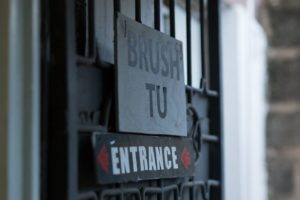
Courtesy of Adam Mwero/Brush-Tu Studio
TT: I’m also curious. Do you think it’s vital for an emerging local artist to go through an artists’ collective to make it like you?
DT: To respond to your question; I think it’s not a must for a local artist to be part of an artist’s collective like Brush Tu, but if it works for them, why not?
TT: Congratulations on your most recent exhibition, Still-in Motion, with One Off Contemporary art gallery. How was the response?
DT: Thank you! It was a success and I received the best feedback from the audience. Most of the work you’ve seen doesn’t come from a new idea but usually stems off from an old thought that has developed and transitioned with time.
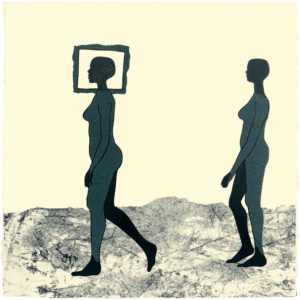
Untitled x (motion), papercuts on paper, 55 x 55 cm, 2019. Courtesy of One Off Contemporary Art Gallery, Nairobi
TT: Fantastic. And what makes up the body of work?
DT: With the Still-in Motion exhibition, I was focusing on a character called The Stroller, who is always in motion and probably the character represents me. I’m always in motion, seeking something depending on what I want or need from that thing at that moment and what I’m meeting along the way.
The exhibition term Still-in Motion is paradoxical or an oxymoronic phrase. The Stroller in the show was moving from one space to another and upon arrival to a temporary one (because The Stroller will move anyway), the subject finds seats; these seats to me are symbolic of belonging to a space. The vacant seat pieces mirror the most basic occurrences where if you find an empty seat, most probably, it was occupied by someone else, and in this case, before The Stroller. The Stroller will be there momentarily and leave the seat for someone else’s inhabiting. So, it was just a general view of society. The seat can be a house or any impermanent niche that provides comfort for that specific time; something that defines your occupation at a specific time or place. The temporariness of the niche is seen in these two specific pieces you asked me about; the character is half, possibly morphing out of the space and has a grey surrounding. The rough edges came about after I intentionally tore the paper and not curved it geometrically. The grey signifies the energy around you as you move between niches. For instance, that comfort or uncomfortable feeling when you take up space. The orientation of the two pieces is important because with the characters, there is a difference between horizontal and vertical, the characters are lying to illustrate how stable and comfortable they are in that specific environment. The characters are layered; there is that patterned background, empty white background and then the grey background. I use grey to mean the energy is transitional since this shade is neither black nor white.
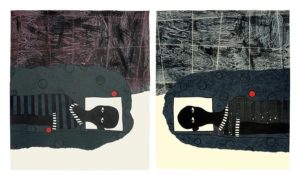
Untitled iv (temporary niche), papercuts and acrylic glazes on paper 114, 5 x 100 cm, 2019/Untitled v (temporary niche), papercuts and acrylic glazes on paper, 111 x 94 cm, 2019. Courtesy of One Off Contemporary Art Gallery, Nairobi
TT: Why did you go for paper as your choice of medium?
DT: Since my college days, I’ve been experimenting a lot with different materials. To me, each idea normally chooses its own material. In the last 5 years, I’ve been experimenting with paper. For this body of work, paper was the perfect material. I wanted to work with layers. The idea isn’t about the completeness of works but the process. This includes the physical creation process. And the process of these characters was more based on layers. I use a specific spray adhesive that’s acid-free to stick the paper. I did some research on adhesives to ensure that it doesn’t change the color or distort character of the paper. I use assorted papers. For this series, I used 300 gsm watercolor paper and of course oil based paper because of some oil textures that created marble like effect in the work. I also used different types of paper that have no names ha-ha. But most importantly, I treat all types of papers before using them. As stated earlier, this is a process of experimenting. Therefore, some papers work, while others don’t.
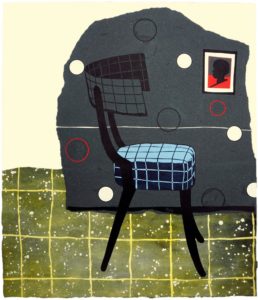
Uuntitled xiii (empty seats), papercuts and acrylic glazes on paper, 89.50 x 77 cm, 2019. Courtesy of One Off Contemporary Art Gallery, Nairobi
TT: What’s your major achievement as an artist?
DT: My foremost accomplishment that kept giving is having the freedom to use paper in my work any way I wanted. I felt a high level of contentment the moment I started focusing on paper and being free as an artist. This artistic freedom created other achievements such as my work showing in 1-54 Contemporary African Art Fair.

Untitled xiii (empty seats), papercuts and acrylic glazes on paper, 89.50 x 77 cm, 2019. Courtesy of One Off Contemporary Art Gallery, Nairobi
TT: Interesting response. What of, your lowest moments?
DT: My lowest moment as an artist was when we lost a friend who was like a brother to me. The Late Ngene Mwaura aka Sheepgoat’s death was a shock. He was still young in the Nairobi art scene. He had just returned from living and studying abroad and he had a bright future ahead of him. We used to talk a lot and support each other. He had exciting ideas and concepts we had discussed that were yet to be executed. May his soul rest in peace.
TT: My heartfelt condolences. If it’s alright with you, I would like to hear your thoughts on art auctions. Do you think there is any significance of these auctions in the African Contemporary art market?
DT: I think I will quote someone in response to that question; The value of the work in an auction doesn’t reflect the actual value of the artwork. An auction is just a competition where people with money bid to acquire a piece of art. What I can add is, auctions can add value to an artist or not, it depends on a lot of dynamics.
TT: Any advice or tip to any emerging artists who might be reading this article.
DT: Keep making art and keep trusting your own thoughts. If you can think of it, just create it. Forget about the rules, just be free, experiment and explore different materials. Take care of the product first and the rest shall follow. One last art business tip for artists is to try to do some research on an art dealer, gallery or curator before getting into any business or sending work.
